PRESTO PLANS
Sent straight to your inbox
CLICK HERE TO ACCESS
Sign up to receive 10 ready-to-use ELA resources your students will love!
10 FREE ELA RESOURCES
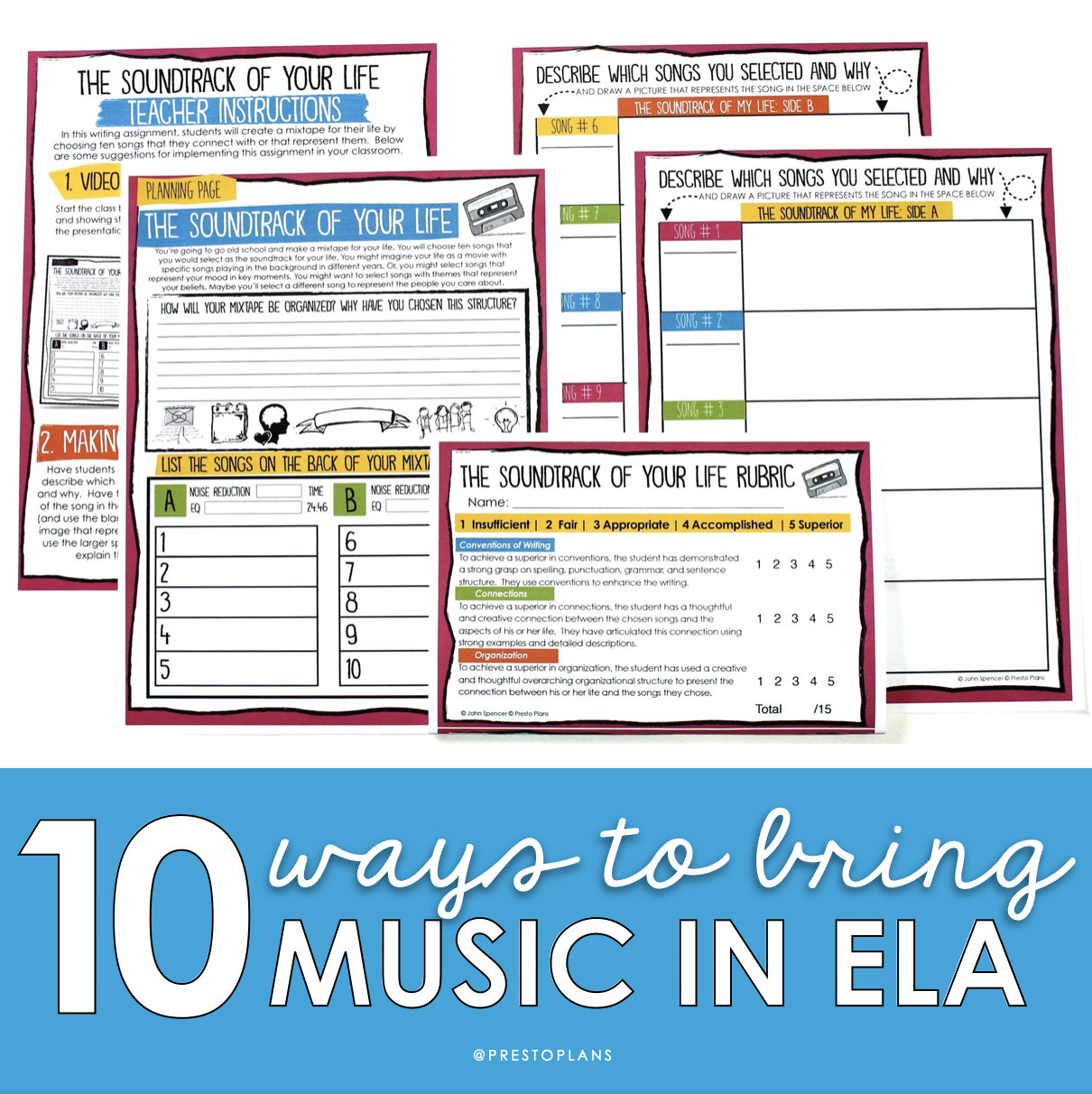
10 Ways to Bring Music Into the ELA Classroom
Have you ever found yourself lost in a great song? I love bringing music into my ELA class. Music adds depth and color to the human experience and is one of the most powerful learning tools at our disposal. Music has the power to inspire, heal, bring people together, and create powerful change.
As a teacher, I think one of the most magical things about music is its ability to create connections between people, and give voice to complicated ideas, feelings, and emotions. This is why my students (and I) enjoy incorporating music into our ELA lessons.
Here are my ten favorite ways to bring music into my middle and high school ELA classes…
1. Poetry Analysis
One of the most natural ways to incorporate music into your middle school ELA class is during your study of poetry. Whether you do a dedicated unit on poetry at a certain time or intersperse poetry throughout your other units of study, music can provide a relatable (and fun!) gateway for your students.
For example, in my classroom, I like to use a mix of classic and popular songs to help my students explore rhyme schemes and various poetry forms. When teaching annotation, especially for the first time, I find that starting with familiar lyrics helps my middle school ELA students make stronger observations and connections.
Sometimes, I begin with a pop song most students know (I love Katy Perry!). Then, I move to a less familiar song (maybe something from their parents’ or grandparents’ generation). Finally, I have them annotate a completely unfamiliar song, or practice the same skill with a more traditional poem.
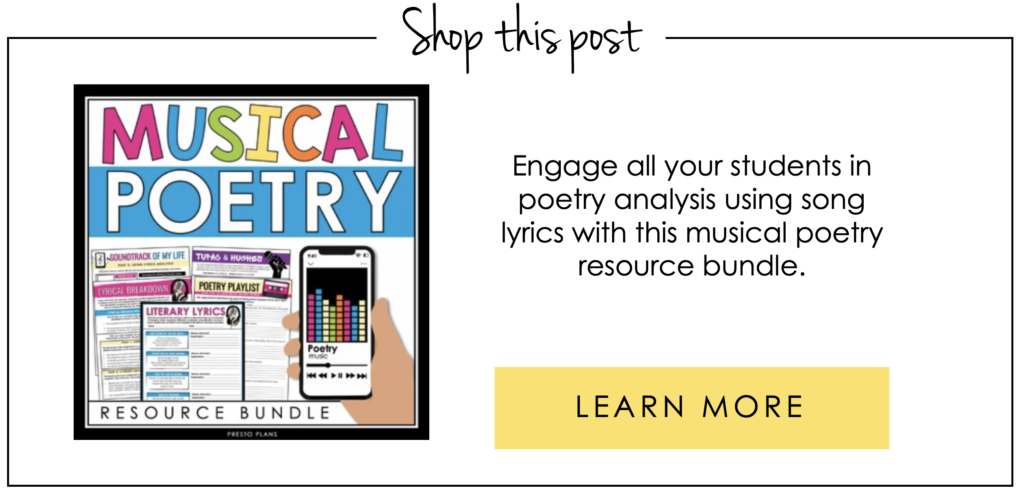
2. Soundtrack of My Life
At the beginning or end of the school year, I love inviting my middle school ELA class to think about the songs that would be on the “soundtrack” of their lives. My students find it fun (and retro!) to think of this assignment as a mixtape with ten songs on it.
To begin, I invite them to think about the overall theme of the playlist. For example, they might imagine their life as a movie, with specific songs representing different years. Or, they might prefer to select a different song to represent the people they care about, their mood in various key moments, or their beliefs.
Next, I ask them to explain their choices in writing, using a graphic organizer for support. During this process, I encourage my students to make strong connections with each song and how it relates personally to their life. Finally, I break my class into small groups and let them share their mixes with each other!
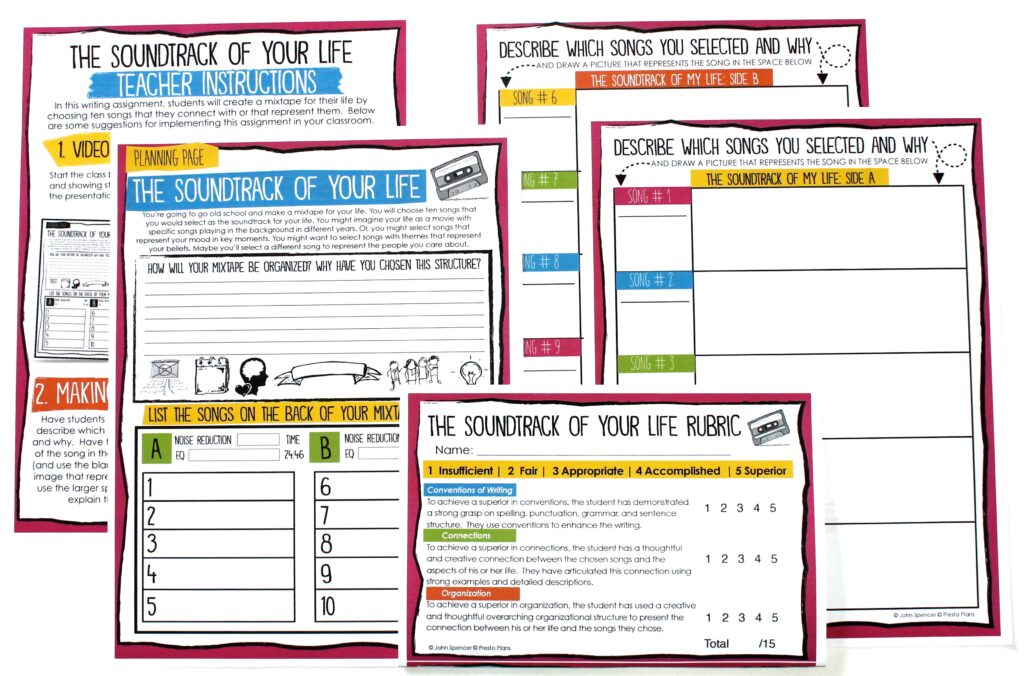
3. Character Playlist or Story Theme Song
Sometimes, a musical connection can help students get a stronger understanding of a character from a novel or story. When I want my students to think deeply about who literary characters are, I ask questions like:
- What songs would that character listen to?
- Why would they connect with these songs?
- What songs would the character listen to at this moment in the plot? Why?
Like the Soundtrack of My Life task, students could develop an entire playlist for a character from a novel. For example, when considering Ponyboy from S.E. Hinton’s The Outsiders, they could select a series of songs, and explain how they represent his changing feelings throughout the novel.
Alternatively, this could be done as a collaborative project or presentation, with each student selecting a song to represent a specific character, scene, or emotion from the book.
When I don’t have time for my students to create an entire playlist, I still like to bring music into my ELA classroom by asking them to create a theme song for a specific character, or a short story or novel as a whole.
4. Figurative Language
I love when students are able to make a real-world connection to ELA learning! Bringing contemporary music into my ELA classroom is an engaging and fun way to help my students understand figurative language.
At the beginning of a lesson on figurative language, I like to play a clip from a familiar song, like “Bam Bam” by Camila Cabello:
That’s just life, baby
Love came around
And it knocked me down
But I’m back on my feet
Then, I ask them to identify the figurative language example from the clip and explain how they know. Most of them figure out that it is personification pretty quickly! From here, I like to give them time to practice by introducing the Literary Lyrics task.
Working alone or in groups, I have students examine clips from a variety of songs they already know, including “Diamonds” by Rihanna, “As It Was” by Harry Styles, and “Anti-Hero” by Taylor Swift. After they have read the excerpts, they use a graphic organizer to label figurative language examples of metaphor, simile, hyperbole, personification, alliteration, pun, oxymoron, and more!
Lastly, I like to have my middle school ELA students explain how or why each lyric is an example of a specific poetic device before I reveal the answers!
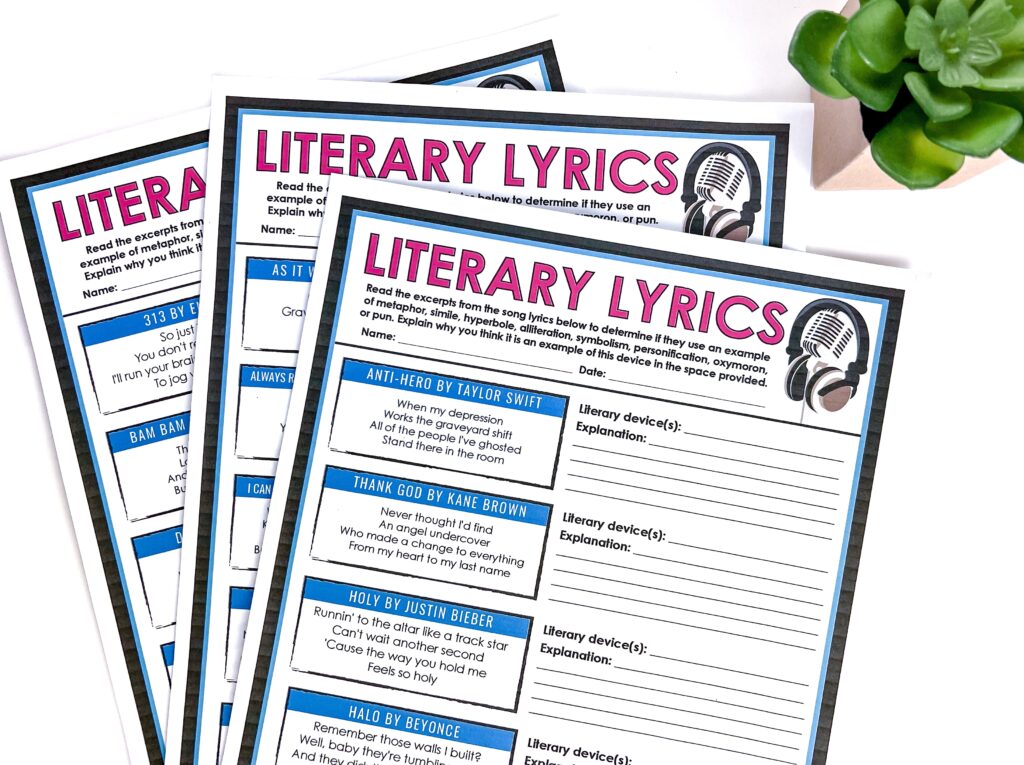
5. Persuasive Language Jingles
Do you ever get a song from a commercial stuck in your head? Jingles, or songs used in advertisements, are a really effective persuasive technique, and yes, I think they totally count as incorporating music in the ELA classroom!
When I teach about persuasive language, I like to give my students an overview of pathos, ethos, and logos before breaking them into pairs or small groups to complete a persuasive language scavenger hunt!
You might want to provide them with several examples of jingles and advertisements that use these techniques, or you might prefer them to research persuasive jingles on their own. Either way, their mission is the same – they need to locate jingles and advertisements that use these persuasive techniques and evaluate whether the language used in the ads is effective.
Sometimes, I wrap up the lesson by inviting my class to write their own jingle or advertisement. I am always surprised at what they come up with!
6. Grammar Music Mistakes
Incorporating music in the ELA classroom is especially fun when you make it into a game for your students! I like to surprise my students by incorporating music into topics they sometimes find dry or challenging, like grammar. I find that this really breathes life into the subject and makes the learning “stick.”
One activity that my students especially like is Musical Mistakes. In this task, my middle schoolers examine task cards that contain song lyrics with grammatical errors in them. To begin, I demonstrate with an example from my own student years, the Backstreet Boys song “I’ll Never Break Your Heart.” We look at the lyric:
As time goes by
You will get to know me
A little more better.
Then, I point out that the issue here is the expression “a little more better,” because it uses words that are not required! I explain that “better” by itself signifies the same meaning without the words “a little more.” Usually, I add that this would be the equivalent of saying someone is “more prettier” (which is also incorrect!).
As students work to correct the grammatical errors on their task cards, which also include tense shifts, slang, and issues with pronouns and contractions, I also ask them to re-write the lyric with correct grammar.
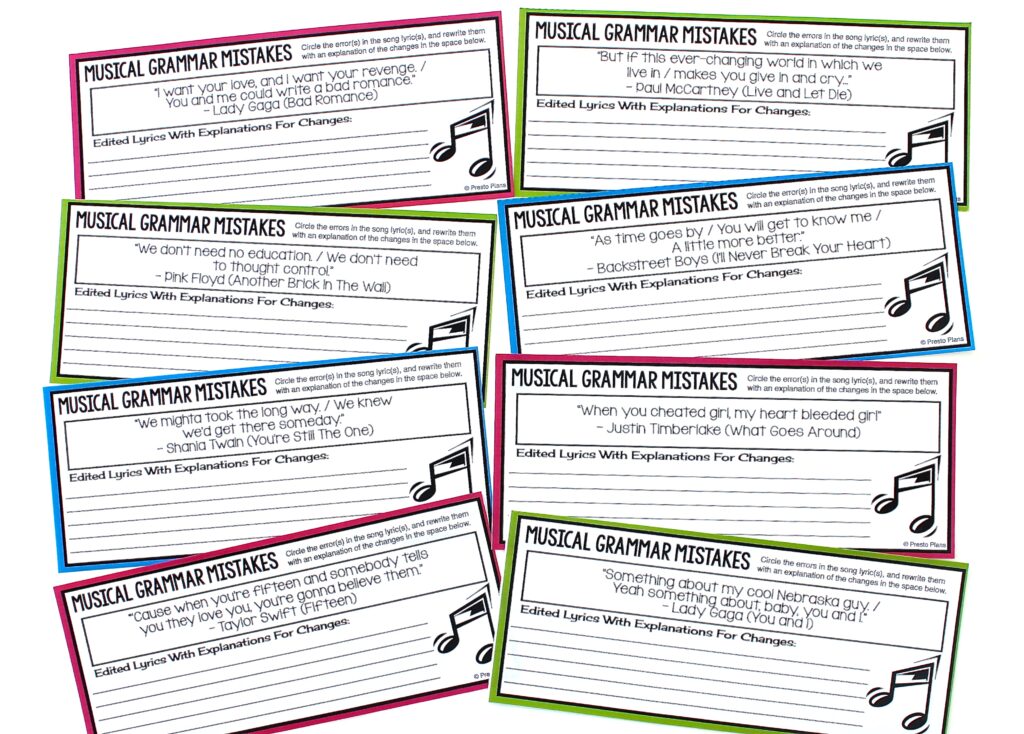
7. Vocabulary in Context
Have you ever encountered a word for the first time while listening to a song? This happened to me when I was listening to the Hamilton soundtrack. In the song “Wait For It,” the character Aaron Burr sings “I am inimitable, I am an original.” I had to look up what inimitable means (it’s a synonym for unique)!
Figuring out what words mean in context is an essential ELA skill, and bringing music into the ELA classroom is a great way for students to practice.
One thing I like to do is provide lyric sheets for various songs to my students, highlighting unfamiliar or more challenging vocabulary words. Then, students work to determine the meaning of the words in context. To wrap up, we might make the vocabulary words into a word wall that can be displayed on a classroom bulletin board.
8. Growth Mindset Music
If you’re like me, you’ll probably find that you talk about growth mindset throughout the year! I find that music is a great way to connect students with the concepts of self-reflection, overcoming obstacles, and growth mindset. This is especially true at the beginning of the year, when I’m setting the tone of my middle school ELA classroom, or right after the winter break, when we focus on new year’s resolutions.
To introduce the growth mindset activity, I play my students a song like “Unstoppable” by Rascal Flatts, “Win” by Bryan McKnight, “A Little Too Much” by Shawn Mendes, “Rise” by Katy Perry, or “The Climb” by Miley Cyrus. Sometimes, we work as a class to reflect on the meaning of the song or other times, students work in groups to make connections to the song’s lyrics. During this task, I like to make sure I model the language of poetry, referring to different stanzas, figurative language, and symbolism.
Finally, I like to extend this activity by asking students to complete a short piece of writing about the overall message of the song, and whether or not they think it could apply to their own life.
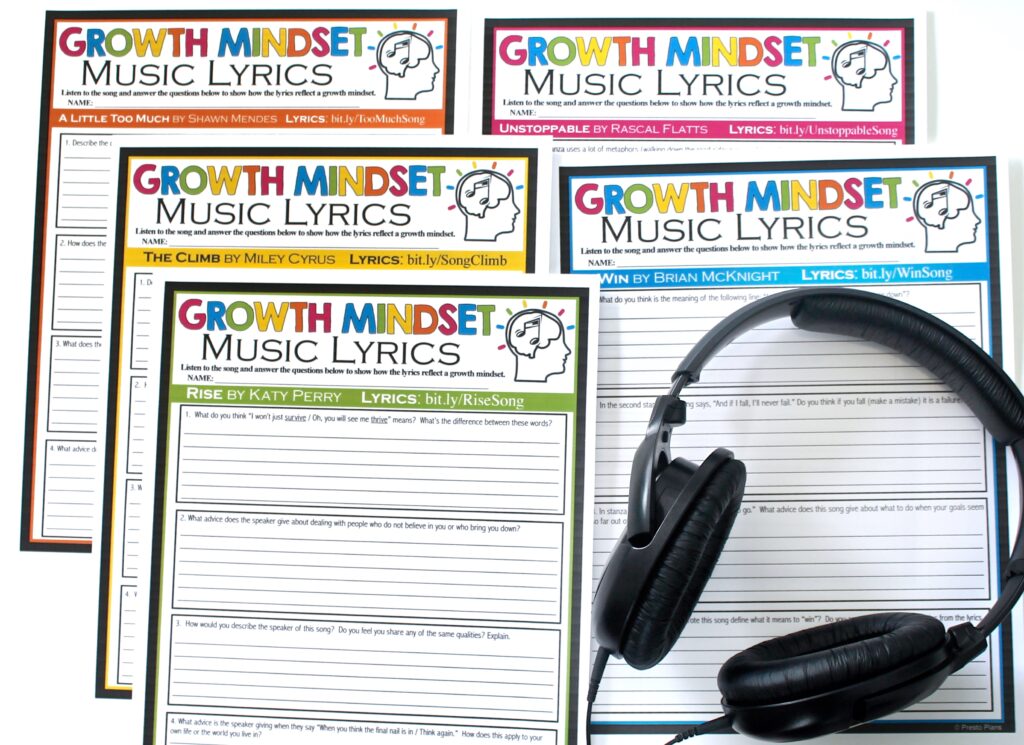
9. Musical Idioms
I find that for some of my students – especially English language learners – idioms can be a tricky concept to understand. The meanings of idioms cannot easily be deciphered by looking at the literal meaning of the words, which makes phrases like “salt in the wound” or “rain on my parade” especially challenging for middle schoolers.
In my experience, bringing familiar music into the ELA classroom can support them in understanding idiomatic expressions. To do this, I like to play a matching game called Musical Idioms, which incorporates idioms from a number of popular songs!
HERE’S HOW IT WORKS:
First, I print out the card template in color, and separate the pink “Musical Idioms” cards from the blue “Idiom Definition” cards. Then, I mix the cards in the two piles up and give them to my students. You will need multiple sets of cards if your class is all playing at once, but only a set or two if you have the game set up as a station in your learning space.
When it is time to play, students look at the pink cards, which feature idioms from popular songs. For example, they might examine a card with lyrics from the One Direction Song “One Thing” that says:
Now I’m climbing the walls.
But you don’t notice at all.
Next, they look at the blue cards and see if they can find the definition that corresponds with the idiom in the song. In this example, the correct match is the definition that identifies “climbing the walls” as an extremely unpleasant feeling of worry or anxiety.
This game is also a great activity when I want to provide additional opportunities for ELA students to practice understanding words and phrases in context.
10. Practicing Inference Skills
Have you ever noticed songs where the meaning is implied, but not overtly stated? I find that many of my students need more practice making inferences and predictions. Bringing music into my ELA lessons is a really effective way to explore these challenging concepts.
In the Inferring With Music activity, I begin by printing out the lyrics to several songs where the meaning requires the listener to “read between the lines.” From here, I invite my students to take a closer look at specific lyrics or stanzas for clues about the song’s meaning.
When we look at the Taylor Swift song “Teardrops on My Guitar,” for example, they need to consider the implied relationship between the speaker and “Drew” before making a prediction about whether or not they will end up together.
There you have it! I really hope this list gives you some out-of-the-box ideas for bringing music into your ELA classroom. Finally, if you’re looking to combine music and poetry in your ELA classroom, you should definitely check out the musical poetry resource bundle below:

Looking for ways to make your poetry unit more collaborative? Check out my post on 3 Collaborative Poetry Challenges Your Students Will Love.
You might also like one of my favorite assessments: Analyzing Poetry with One-Pagers!
Search the blog for what you are teaching
GIVEAWAYS
sent straight to your inbox!
share this post